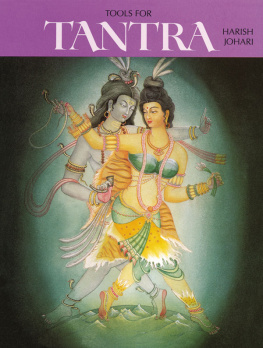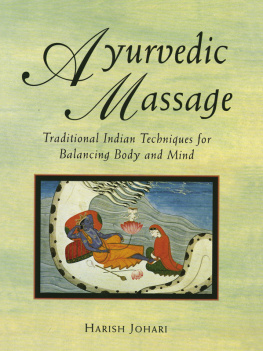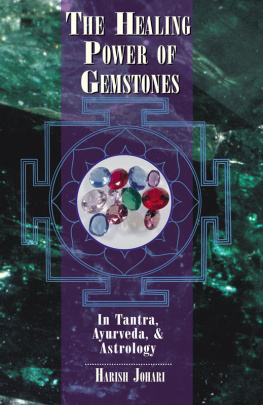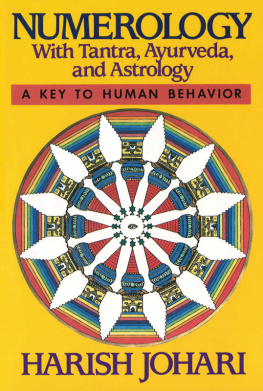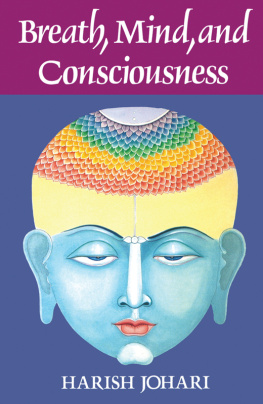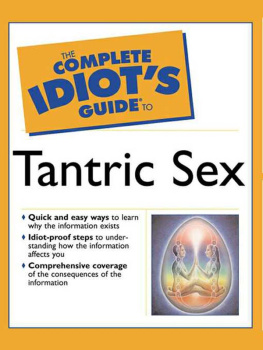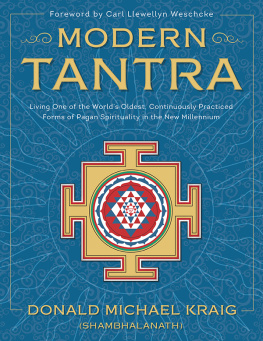Harish Johari - Tools for Tantra
Here you can read online Harish Johari - Tools for Tantra full text of the book (entire story) in english for free. Download pdf and epub, get meaning, cover and reviews about this ebook. year: 1988, publisher: Destiny Books, genre: Religion. Description of the work, (preface) as well as reviews are available. Best literature library LitArk.com created for fans of good reading and offers a wide selection of genres:
Romance novel
Science fiction
Adventure
Detective
Science
History
Home and family
Prose
Art
Politics
Computer
Non-fiction
Religion
Business
Children
Humor
Choose a favorite category and find really read worthwhile books. Enjoy immersion in the world of imagination, feel the emotions of the characters or learn something new for yourself, make an fascinating discovery.
- Book:Tools for Tantra
- Author:
- Publisher:Destiny Books
- Genre:
- Year:1988
- Rating:4 / 5
- Favourites:Add to favourites
- Your mark:
- 80
- 1
- 2
- 3
- 4
- 5
Tools for Tantra: summary, description and annotation
We offer to read an annotation, description, summary or preface (depends on what the author of the book "Tools for Tantra" wrote himself). If you haven't found the necessary information about the book — write in the comments, we will try to find it.
Tools for Tantra — read online for free the complete book (whole text) full work
Below is the text of the book, divided by pages. System saving the place of the last page read, allows you to conveniently read the book "Tools for Tantra" online for free, without having to search again every time where you left off. Put a bookmark, and you can go to the page where you finished reading at any time.
Font size:
Interval:
Bookmark:
GOD
the Immovable Mover,
the One
behind all events in the cosmos,
is
the still point,
the bindu
around which
everything
revolves,
because He is still with peace of love
and yet
dancing eternally
in everything that exists.
His dance is union,
union of elements;
His dance is rhythm,
pulsation of life.
All forms are bound
in a single stream
a thread, a link
a uniting force
be they plants, animals, or stars.
The threads ofgunas behold the action,
and puppets of tattvas eternally dance.
Actions are karmas,
Patterns are samskaras,
Emotions are Mudras,
And the keen desire to reunite
Creates the Dance in the Immovable Mover
The bindu.
Harish Johari
Ananda Ashram
January 18, 1983
Tantra is the study of the universal from
the point of view of the individual.
The practicality of Tantric doctrines makes
Tantra a select science that links all
sciences and uses their essence in
preparing workable formulae.
Tantra is not limited to the study of any
one branch of the tree of life.
It is the study of the tree of life.
Tools for Tantra
by Harish Johari

Color Plates
AUTHORS NOTE
The author is indebted to all those friends and guides who helped him in presenting this edition, especially Jeanet Hazen-berg for her work on the line drawings and colored yantras and Heidegret Rauhut for typing the manuscript. Their efforts are dedicated to coming generations for the development of the inner life and the continuation of the spirit of Tantra, which is constant search and research.
SOURCES OF SUPPLY
Shri Center
P.O. Box 2927
Rockefeller Center Station
New York, NY 10185
CHAPTER ONE
WHAT IS TANTRA?
Tantra is a holistic approach to the study of the universal from the point of view of the individual: the study of the macrocosm through the study of the microcosm. It draws on all the sciencesastronomy, astrology, numerology, physiognomy, physics, chemistry, alchemy, Ayurveda (the traditional medicine of India), psychology, parapsychology, mathematics, geometry, and so onto provide a practical means of realizing the highest ideals of philosophy in daily life. Instead of separating and categorizing the different areas of human knowledge, Tantra draws them together like beads on one string. The beautiful rosary thus formed is a unique instrument for enhancing the physical, mental, and spiritual life of man and woman.
Put another way, Tantra studies the tree of life itself instead of limiting itself to any single branch of the tree. This tree, this macrocosm, is a great organization of diverse elements, linked together by a unifying law (dharma) that is inherent in their very nature. Tantra seeks to understand this law, which has organized the diverse phenomena into the world of relative existence (maya), and to use it to promote the evolution of individual consciousness. As stated in the Kashika Vritti, Tantra is that knowledge which expands mind, body, and consciousness.
The aim of Tantra, then, is to expand awareness in all states of consciousness, whether waking state, dream state, or deep sleep. To accomplish this, we need a kind of deprogramming and reprogramming of our human computer. Our birth in a particular place and time gives us our primary programming, influenced by heredity and environment. If we are content with the results and live our lives without too many problems, then we will see no need for change. But when we experience great difficulties in life or begin to seek something beyond our limited program, then we need away to alter it. Tantra provides the methodology and the tools for this work. It teaches us to identify the various factors that influence our thoughts and feelings and to transcend the obstacles to our evolution arising from ignorance, intolerance, attachment to our animal nature, and selfishness. By refining our thoughts and feelings by means of Tantric practices, we learn to create peace, harmony, and order within ourselves. Tantra thus promotes a one-pointedness and centeredness that help to free the consciousness from limitations.
SHAKTI
People often think of Tantra as a mother-worshiping cult. This is not strictly accurate, although Tantra might be called a shakti-worshiping cult. Shakti is the universal principle of energy, power, or creativity. This energy is personified as feminine, as Shakti, the Universal Mother. She is inseparable from the one who beholds herthe shaktiman (power-holder), the masculine principle or Universal Father. Shaktiman is called Brahman by the writers of the Upanishads. In the Tantric tradition he is called Shiva.
The universe is in fact a product of this pair of opposites: one static (shaktiman) and the other dynamic (shakti). The external part of everything is the creative aspect of the dynamic force, and inside every dynamic creation is the static force, which is the nucleus of phenomenal existence.
The play of shakti has no beginning or end. Although it is restless, the energy does move in an orderly cycle, alternating periods of motion and rest. During the period of motion, through permutations and various combinations, the energy undergoes many changes ( vikriti) and gets distorted. It reorganizes itself during the period of rest, and thus a continuous process of creation, preservation, and destructionreorganization and re-creationgoes on forever. Tantra believes that as long as the phenomenal world exists, it is the Universal Mother who is the creator, preserver, and destroyer. Thus she should be worshiped as an aspect of the Divine.
What is the motivating force behind this eternal play that creates the illusory world of phenomena? It is the power of desire (ichchashakti). This desire is present in the one who is without attributes, the nameless and formless aspect of the divine (Brahman or Nishkal Brahman). Tantra performs the unique work of studying this principle of desire.
DESIRES AND THE CHAKRAS
Since Tantra accepts desire as the prime motivating force of the universe, it does not ask its aspirants to renounce desire. Other spiritual sciences advise the avoidance of desire, which they claim leads to bondage and is an obstacle to achieving higher consciousness. They try to overcome desire through asceticism or by roasting the seed of desire in the fire of knowledge so that it cannot sprout. Yet one is left with the paradox that to achieve desirelessness, one must have a strong desireto be desireless!
Tantra asserts that desires are natural and that as long as we are embodied, we will have them. Our sense organs serve as windows through which desires enter. That is, desires are created out of our attachment to sensory input. All desires have a physical basis in innumerable electrochemical impulses. The more we try to suppress them, the stronger they become. Desires activate the secretion of hormones from the endocrine glands. The concentration of these substances in the blood, arising from the suppression of desire, appears as chemical disturbance or disease.
Desires are directly related to the six psychic centers known as the chakras. As the energy in its natural course moves through the different chakras, in concert with the movement of the Earth in the heavens, it energizes the latent desires of those chakras. This makes a person move from one desire to another during the twenty-four-hour cycle of a day. Our physical reality is directly influenced by the force of gravity of the Earth and by the environment created by the celestial bodies and the electromagnetic currents flowing within the planet.
Next pageFont size:
Interval:
Bookmark:
Similar books «Tools for Tantra»
Look at similar books to Tools for Tantra. We have selected literature similar in name and meaning in the hope of providing readers with more options to find new, interesting, not yet read works.
Discussion, reviews of the book Tools for Tantra and just readers' own opinions. Leave your comments, write what you think about the work, its meaning or the main characters. Specify what exactly you liked and what you didn't like, and why you think so.

